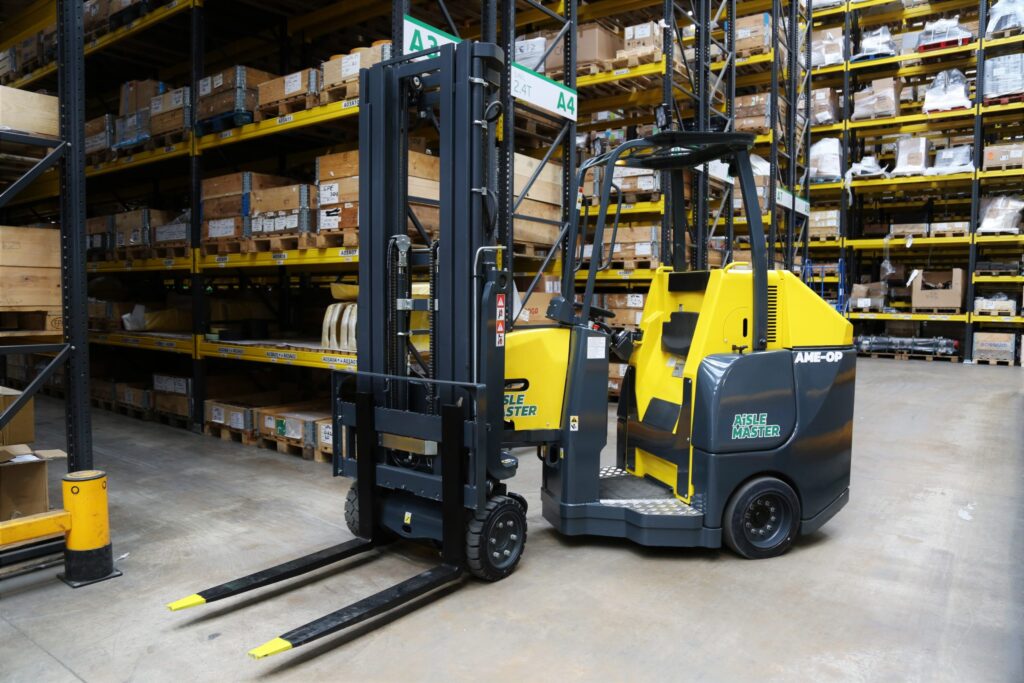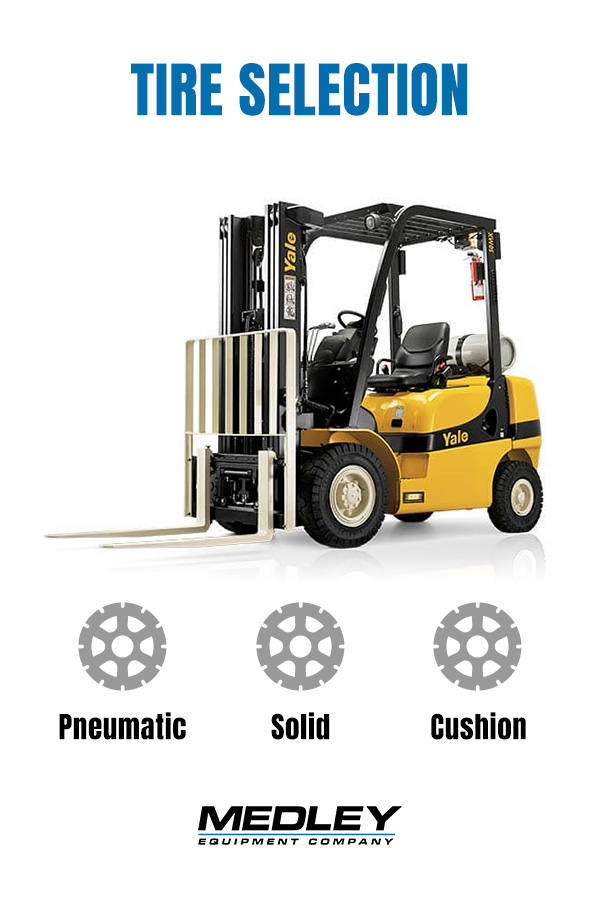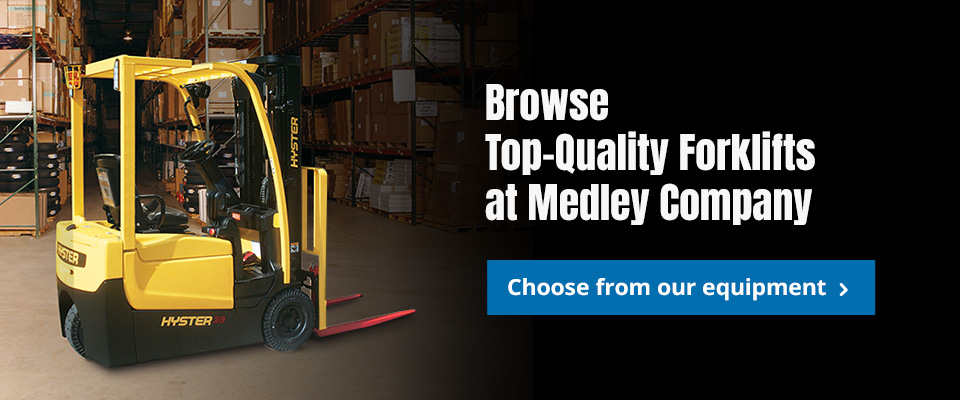
When it comes to choosing a forklift, it’s important to find the most productive and cost-effective machine. Beyond just the size and power source, you’ll want to consider factors like how often you’ll need the machine, lift height, tire selection and more. Most importantly, the right forklift will get the job done safely and efficiently.
Here are different factors to consider when selecting the right forklift for your business.
Application
Given the variety of forklift uses and types, you’ll want to choose one specifically designed for your job. Determine your specific needs by considering:
- The amount of hours the forklift needs to operate per day
- The amount of space available to work in
- Whether you’ll be working indoors, outdoors or both
- The size, weight and shape of the loads you’ll be lifting
- The height at which your forklift needs to lift
The right machinery impacts everything from productivity to operational costs. The best option will help you meet deadlines and complete jobs safely.
Forklift Type
Forklifts use different fuel types with varying pros and cons. Consider the following kinds of fuel to help you choose the right forklift:
- Electric: Electric forklifts come in various models and styles, from sit-down riders to pallet jacks, stackers and reach trucks. They are the more environmentally friendly option since they don’t produce emissions. However, these forklifts require a dedicated battery charging station with temperature-controlled conditions.
- LPG: You’ll find plenty of forklifts that use liquified petroleum gas (LPG) or propane. These versatile options can be used indoors and outdoors, and they often have a lower upfront cost than electric forklifts and lower fuel costs than diesel-powered ones.
- Diesel: Off-road diesel forklifts offer greater stability on uneven terrain than other fuel types. Refueling is faster and easier than changing LPG tanks or charging batteries. However, they cannot be operated indoors and often have higher maintenance costs due to moving parts.
- Gas: These forklifts lift heavy loads quickly and efficiently, making them ideal for demanding work environments. Cons include that they produce emissions and are typically less powerful than diesel forklifts.
Load Capacity
You need a forklift that meets your maximum capacity requirements. Think about the following:
- Items your forklift must handle
- Average load weight of your task
- Heaviest load the forklift must lift
- Type and width of each load
It’s essential to consider your specific load type, as there are particular forklift attachments you might invest in to enhance your machinery and help you move and load more efficiently.
Lift Height
When selecting a forklift, it’s important to determine your required lift height. Forklifts can vary in lift height, with some reaching over 20 feet. The right one will depend on your task, warehouse size and the intended forklift application.
Consider the following:
- The typical height you work at
- The highest point your forklift must reach
- Any height restrictions like ceiling beams
- The collapsed height of the mast, if you need to move beneath a fixed structure
- Your warehouse height and aisle width requirements
Tire Selection

Another important consideration is the forklift tires. The most common tires for forklifts are:
- Pneumatic: These options are designed for heavy-duty lifting on various terrain, making them ideal for outdoor tasks. Wider and longer than cushion tires, pneumatic tires are made of rubber and filled with compressed air.
- Solid: Solid tires are durable and will not pop or puncture compared to pneumatic tires. They are ideal for heavy-duty applications like lumber yards and construction zones. Due to their durability, these tires are often more expensive than other options.
- Cushion: These forklift tires are constructed from solid rubber and sit lower to the ground than pneumatic tires. The positioning makes them highly maneuverable. Even so, low ground clearance restricts them to indoor applications only, as they can get stuck on uneven terrain and other obstacles.
Attachments
Forklift attachments and accessories can lower the total cost of ownership by allowing one machine to perform multiple tasks. Popular equipment attachments include:
- Side shifter: A side shifter attachment allows you to move from side to side, making minor adjustments to your pallet’s alignment without maneuvering the entire forklift.
- Rotator: This helpful attachment lets you safely and efficiently rotate the forklift 360 degrees while moving loads. A rotator can help you limit downtime and improve overall productivity.
- Fork extension: When you need extra length, fork extensions can help you handle the occasional awkward load that extends just past the tips of your forklift’s tynes.
Other popular forklift accessories include hook plates, drum sides and man baskets.
Maintenance and Service
It’s crucial to work with a forklift provider that offers prompt services if any problems arise. That way, you limit downtime and keep operations running smoothly. Choose a provider with multiple locations and a range of solutions that provide what you need to get the job done.
When deciding on the right dealer, ask these questions about their maintenance and post-sale support:
- Number and availability of service technicians
- Availability of top-quality parts
- Turnaround times
Buying or Renting
Consider the advantages and disadvantages of buying and renting a forklift. Purchasing your forklift outright means having a capital asset you can use for collateral loans. Compared to renting, buying can also be more affordable when you need a forklift for a long-term project. If you plan on reselling, you may see a higher return on investment, as long as you’ve cared for your equipment.
Renting is often the more flexible option, as it allows you to use your forklift for however long you need before returning it. Renting can also be more economical when fulfilling a temporary requirement or short-term project. However, the convenience of renting comes with monthly costs compared to purchasing a forklift, as well as contracts and fees if you use it beyond the contracted limit.
Browse Top-Quality Forklifts at Medley Company
Many factors contribute to choosing a forklift that fulfills your demands efficiently and safely. The right forklift can mean increased productivity, better employee morale and an improved bottom line.
At Medley Company, our experts can help you find a forklift that meets your requirements and helps you complete any task. We service and carry parts for all makes and models of aerial lifts, forklifts and other material handling equipment. Choose from a range of new equipment and rental options in our inventory.
Working with our team means fast response times and superior customer service. Contact us today to get started.

